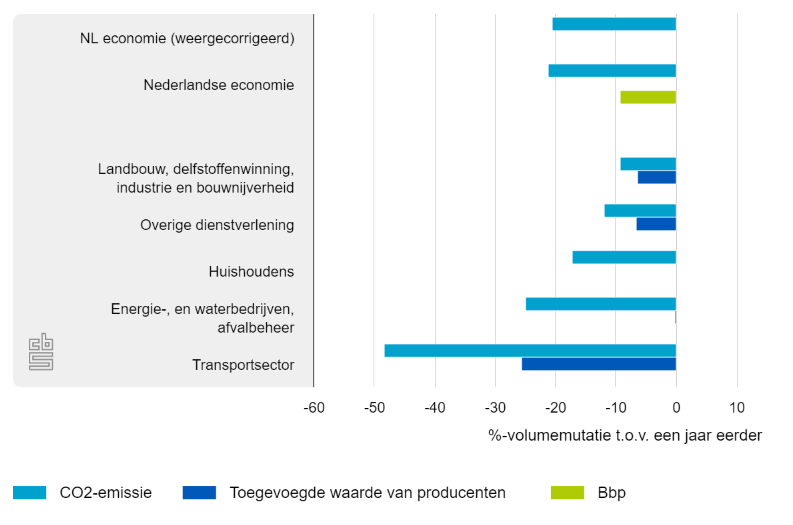News 15 September 2020 News from SKAO
More than a fifth less CO2 emitted in the second quarter of 2020
CO2 emissions from Dutch economic activities were 21.1 percent lower in the second quarter than in the same quarter of 2019. According to the first calculation, gross domestic product (GDP) contracted by 9.3 percent in the same period. The decrease in CO2 emissions is partly due to the fact that the energy companies used less coal in their production.
CO2 emissions from Dutch economic activities were 21.1 percent lower in the second quarter than in the same quarter of 2019. According to the first calculation, gross domestic product (GDP) contracted by 9.3 percent in the same period. The decrease in CO2 emissions is partly due to the fact that the energy companies used less coal in their production. The impact of the corona crisis on CO2 emissions is also clearly visible. For example, the CO2 emissions of the transport sector were about half lower than a year earlier. The CBS (Central Statistics Office) reports this on the basis of the new quarterly figures on CO2 emissions.

Figure 1: CO2 emissions and economic development, second quarter 2020
A quarter less CO2 emissions from energy companies
In the second quarter of 2020, CO2 emissions from energy companies, water companies and waste management were about a quarter lower than in the same quarter a year earlier. The energy companies accounted for more than 30 percent of total emissions in the second quarter.
In recent years, electricity companies have used less and less coal and more natural gas. In the first half of 2020 the consumption of coal for the production of electricity is more than 60 percent lower than in the same period a year earlier. Burning natural gas emits less CO2 than coal. Electricity production from renewable sources, such as solar power and wind energy, was higher in the first half of 2020 than a year earlier.
CO2 emissions from households and services are lower
Household CO2 emissions were more than 17 percent lower than in the same quarter a year earlier. Due to the covid-19 outbreak, the cabinet called for staying at home as much as possible and working from home if possible. As a result, emissions from car use in particular decreased. Households also used less natural gas to heat homes because of the relatively warm spring weather. In the second quarter, CO2 emissions from households amounted to more than 17 percent of the total.
CO2 emissions from other services were nearly 12 percent lower than in the second quarter of 2019. The share in total CO2 emissions is more than 11 percent.
Agriculture and industry also emit less CO2
In the second quarter, CO2 emissions from the agriculture, mineral extraction, industry and construction cluster were 9 percent lower than in the same quarter last year. In the second quarter of 2020, this cluster accounted for more than 31 percent of total emissions. The chemical and basic metal industries in particular have emitted less.
CO2 emissions in the transport sector almost halved
The transport sector emitted almost half less CO2 in the second quarter than in the same quarter a year earlier. The added value was also considerably lower in this period. CO2 emissions from aviation were more than 80 percent lower in the second quarter than twelve months previously. Due to the Corona outbreak, many flights were canceled in the second quarter and a large part of the fleet was grounded. Road transport has also emitted considerably less CO2 due to the corona crisis. The share of the transport sector in total emissions was over 9 percent.

figure 2: Contribution of CO2 emissions by industry and households, second quarter 2020
-
The CO2 emissions have been calculated according to the definitions in the Environmental Accounts. This concerns an initial calculation based on the information then available. The figures can change on the basis of new statistical source information that becomes available later.
CBS Netherlands has also developed a method to estimate quarterly greenhouse gas emissions in accordance with the regulations of the Intergovernmental Panel on Climate Change (IPCC). These regulations, drawn up in the context of the Kyoto Protocol, ensure comparable emissions between countries in order to be able to pursue international policy. The first experimental results for the first and second quarters of 2020 can be found here.
Source:
Link StatLine - Estimate of CO2 emissions to air; Dutch economy, National accounts
This article previously appeared on www.cbs.nl.
